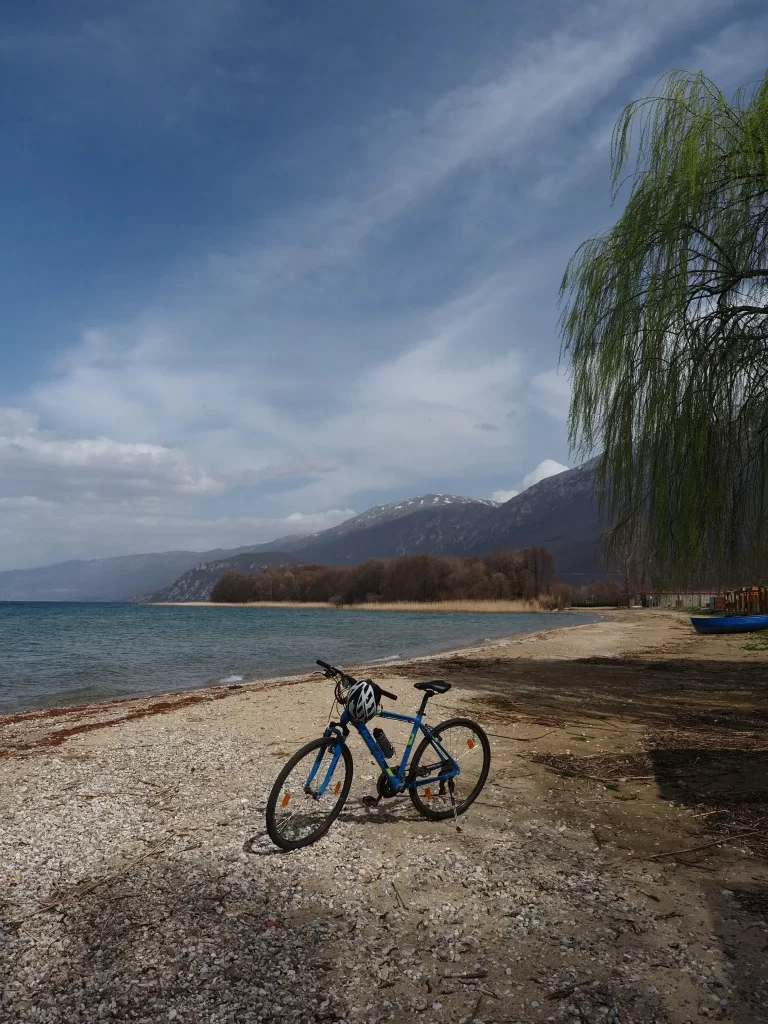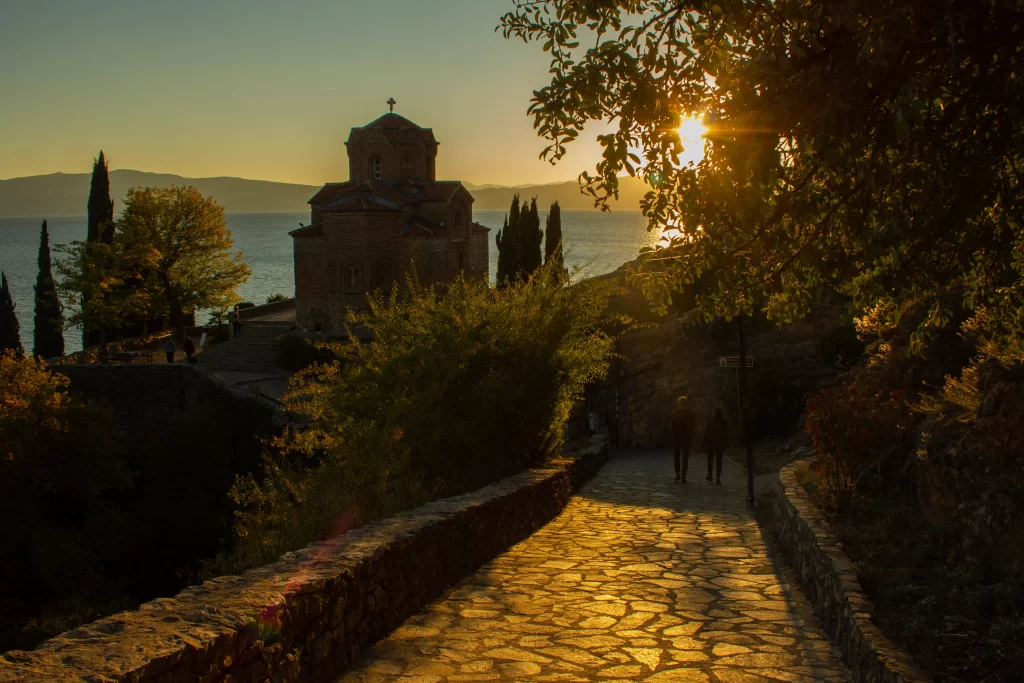Imagine roads with almost no cars, going through vast mountain landscapes and along pristine lakes. Add ancient cultural sites and mystical Orthodox churches with Byzantine frescoes. Combine it with 300 sunny days a year, great food and outstanding hospitality. North Macedonia, a hidden gem in the Balkans, is a perfect place to travel by bike. Here are some practical tips to prepare for your trip.

Jak dojechać?
There are direct flights from Skopje from many European cities (e.g. London, Rome, Brussels, Copenhagen, Paris, and Barcelona, as well as multiple cities in Germany). Many of them are operated by WizzAir, so you should easily find something cheap.
There is also a little international airport in Ohrid, where you can fly from Zurich, Vienna, Dortmund and Memmingen.
Taking a bike on a plane with WizzAir costs 55 euros one way (the bike needs to be packed in a bike bag or a cardboard box, pedals and wheels have to be demounted, and tyres deflated).
Bicycle rental in North Macedonia
If you don’t want or cannot bring your own bicycle, there is a bicycle rental in Skopje with high-quality mountain bikes, like a Bianchi Magma 9.1 29″ mountain bike. The prices vary depending on the length of the rental. If you want to travel for 4-7 days, you’ll pay 1260 MKD/day (ca. 20 euros/day).
The bike was delivered to my hostel’s doorstep. I also received a helmet and the necessary tools (a multitool, spare tube, patches, tyre levers, and a pump). If you need panniers, a child seat, or a carrier, Bicycle.mk can rent it to you, too.
They can also organise the whole trip for you. If you prefer to go light, without baggage, and enjoy the steep, challenging mountains, go on a supported tour with them.

During my last visit to North Macedonia, I stayed in Ohrid and rented a bike from Bike Station Ohrid. They have great mountain, hybrid, and electric bikes, starting from 15 euros/day.

Ukształtowanie terenu
North Macedonia is mountainous; mountains and hills cover 80 % of the country. On my 534-kilometre route, I climbed over 6,700 elevation meters Better make sure that you are in shape before coming here.
Wild camping in North Macedonia
Wild camping in Macedonia is simple, pleasant and – although not officially legal – widely accepted by the locals and authorities. However, if you plan to camp by one of many lakes on weekends, you might have to share it with the locals hanging out by the water. Also, there is often a lot of trash, so you sometimes need to clean up a bit. As a solo travelling woman, I felt pretty safe camping in Macedonia.
Brown bears live in the mountains, so if you plan to camp there, never keep your food in the tent and take the necessary precautions (you can read some tips tutaj). You’ll also meet plenty of stray cats and dogs (usually very friendly).

Noclegi
You don’t fancy carrying all the camping gear with you? No problem! There are a lot of guest houses for a fair price, so you can plan your trip without taking any camping gear with you. Here are some recommendations from me:
- Prilep—Guest House Antika (30 euros for two people in a room with a shared bathroom). The owner (whose family has owned the house for four generations) is engaged, helpful, and always ready to advise.
- The Guest Mansion by the Bigorski Monastery in Rostusa. A comfortable dorm bed costs 19 euros per night, but the view from the window is worth millions! For a double room, you’ll pay 29 euros per night.
Pro tip: if you stay there, visit the restaurant at the bottom of the road to the monastery: Kuka na Mijacite. It serves excellent traditional Macedonian food.
Woda
Along the route, you will usually find springs and taps with potable water. However, the summers in Macedonia are pretty hot, so it is always good to have some extra supplies.


Drog, ścieżki rowerowe i ruch
My favourite thing about North Macedonia is that nearly every big road or highway has a parallel smaller and older empty road. The asphalt is usually a bit worn out but still decent. It was a little busier around Skopje and Struga and on the road from Tetovo to Skopje. The latter is also not the most scenic route—very industrial, with quite polluted air.
During my trip, I didn’t have any dangerous situations. The drivers were usually respectful, although I felt under pressure on the stretch from Tetovo to Skopje, where trucks were honking at me and passing by a bit too close.
Traffic rules
- Your bike should have a front white light and reflector, a rear red light and reflector, brakes on both wheels and a bell.
- Bicycle lanes are only found in bigger cities (Skopje, Ohrid, Prilep); if they are present, you must use them.
- Wearing a helmet is not compulsory.
Pieniądze
Currency: Macedonian Denar (MKD)
100 MKD =1,62 EUR / 1,88 USD
Currency exchange is possible in all major cities and bigger towns.
ATMs are fairly easy to find. I used a Revolut card, which offers a good exchange rate and free card payments (you can order one via this link if you don’t have one yet). You can withdraw money from most ATMs without fees and currency conversion costs (except for weekends, when Revolut charges 1 % of every transaction to cover the eventual risks of market moves). Be careful: ATMs at the airport might charge you a commission.
Internet i karty SIM
I was using Telekom prepaid. For 5GB, valid for 30 days, I paid 499 MKD. The coverage was excellent, and there were only 1 or 2 short stretches in the mountains where I had no reception. I bought it here (you need to bring your ID with you to register the SIM card):
If you want to avoid the hassle of buying and installing a physical SIM card, consider an eSIM. For example, Airalo offers 2 GB of data valid for 15 days for just 7 euros. Another eSIM provider, Yesim, has a special pakiet Bałkański that works in 12 countries. For 5 GB, valid for 30 days, you’ll pay 15 euros.
Najciekawsze miejsca
Ohrid
Ohrid, the most visited place in North Macedonia (but don’t worry – still not as crowded as Venice or Dubrovnik), is known for its rich culture and history and the amazing Lake Ohrid – probably the oldest Lake in Europe. Things to do in Ohrid:
- Watch the sunset at Saint Kaleo church
- Take a swim in the lake. Follow the path on the cliffs up north to find less crowded beaches (by the hotel Partizan, it should be quite empty)
- Visit the ancient basilica and beautiful St. Panteleimon church (and as many other churches as you manage – Ohrid is known as Jerusalem of the Balkans, and each church has some hidden gems like old frescos or icons)
- See how paper is made in the National Workshop of Traditional Paper

Lake Prespa
It is a little younger than Ohrid but no less beautiful. It is a bit less popular and has outstanding biodiversity. If you’re lucky, you can spot pelicans. Dreaming of camping on an island? Take a boat from Stenje to Golem Grad. It is also called Snake Island, so beware of snakes!
Galicica
The highest road pass in Macedonia is 1600 meters high. It crosses Galicica – a beautiful mountain range and national park between the two lakes mentioned above. Cycling the road through the mountains is an experience, but if you decide to get off your bike for a while, you can also climb the Magaro peak (2254 m). Galicica is also known for its excellent paragliding conditions if you need an adrenaline rush.
Mavrovo National Park
With a constantly developing network of MTB trails, the oldest national park of North Macedonia is a perfect destination for a cycling adventure. Most tourists visit Mavrovo Lake with the sunken St. Nicholas church (it is pretty unsunken in late summer/autumn, though). It is also worth doing a hike to Duf Waterfalls. For a cultural experience, step by the St. Jovan Bigorski Monastery (if you visit on a Sunday morning, you will have a chance to listen to hypnotising Byzantine chants of the monks). You should also come by Galicnik – a remote village with only three all-year residents. It comes back to life every year in mid-July thanks to a wedding festival. To experience Macedonian folklore and tradition at its finest, visit Galicnik on Saint Peter’s Day (12th of July).
If you’d like to read more about bicycle touring in North Macedonia, check out my story tutaj.
Any questions about bike touring in North Macedonia? Let me know in the comments section!

Odnośnik zwrotny: Paradise lost - cycling in North Macedonia - Wobbly Ride
Odnośnik zwrotny: Camping alone as a woman - are you gonna die? - Wobbly Ride
Odnośnik zwrotny: Wild camping in Europe - where is it legal and what to do if it's not - Wobbly Ride
Odnośnik zwrotny: Cycling in Albania - practical bike touring guide - Wobbly Ride
Odnośnik zwrotny: Best cycling routes in the Balkans - Wobbly Ride
Odnośnik zwrotny: Cycling in Belgium - practical bike touring guide - Wobbly Ride
Odnośnik zwrotny: Inspiration til cykelture rundt i Europa – Med tog fra Danmark til udlandet